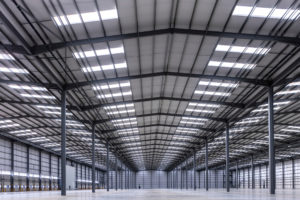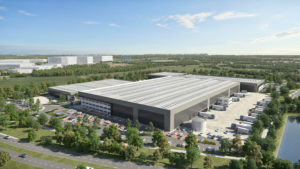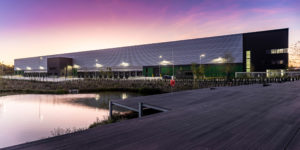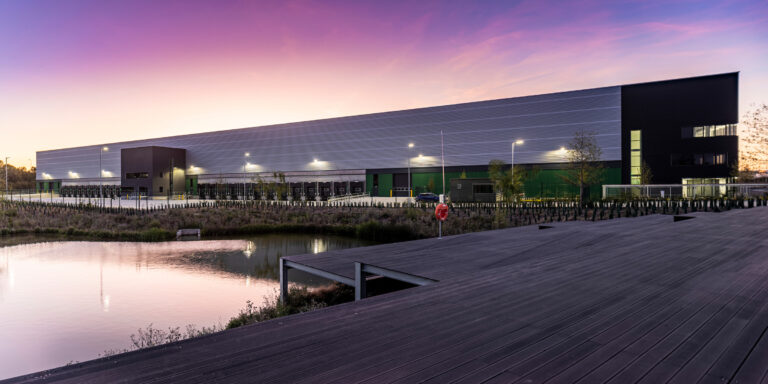Industrial occupiers are selecting sustainable properties as part of a shift in overall business practices. But will it be a trend that lasts? Christopher Walton investigates.
As an occupier of industrial and commercial property Philip Stephenson, chairman of the Davies Turner group, says that its nationwide network of hubs and branches, are almost all built and located on reclaimed brownfield sites, as part of its wider approach to environmental responsibilities.
 Stephenson says the 3PLs new freehold developments comply with the latest post-Kyoto and post-Paris Agreement building regulations: “At Bristol, Central Park Davies Turner included provision in its latest distribution centre for charging electric road vehicles as well as the fleet of forklifts. At the same time, it has replaced all its warehouse and office lighting with LEDs.”
Stephenson says the 3PLs new freehold developments comply with the latest post-Kyoto and post-Paris Agreement building regulations: “At Bristol, Central Park Davies Turner included provision in its latest distribution centre for charging electric road vehicles as well as the fleet of forklifts. At the same time, it has replaced all its warehouse and office lighting with LEDs.”
To that end Sally Duggleby, head of industrial and logistics occupier advisory, at Savills says that when industrial occupiers are selecting property they want to make sure it is fit for the future: “That is something we will see increasing as a trend in the next few quarters,” she says.
Taking into account sustainability as part of overall business practice, she says, means occupiers will be considering the long-term occupational costs and occupational liabilities attached to committing to a property, and asking questions such as “are the conduits ready to receive charging points?” and “Where is the power coming from?”
Her colleague Rebecca Smith, sustainability business manager at Savills, says: “There is definitely a shift in the market in the past year, across all property types, when sustainability can get you ahead. We are at the beginning of that journey with logistics. “

Simon Cox, head of sustainability at Prologis in the UK, concurs and says that for many businesses, warehouse and distribution centres are now central to operations and a primary driver of sustainability.
“Increasingly, they expect these buildings to match the standards of flagship retail stores in terms of build quality, efficiency and focus on employee welfare. As well as certificates of environmental performance, occupiers expect their property partner to be able to provide them with robust data to evidence that the building is low- carbon, both operationally and in terms of its structure and fabric,” he says.
Legislation in property development and construction can make a major difference at source when it comes to sustainability for industrial and commercial property and Richard Carter, senior construction director at St. Modwen Industrial and Logistics, says that legislation’s role should be to set the targets for companies to adhere to, so they establish a standard for the industry as a whole to work towards.
“The legislation set by the government should stretch us while persuading and pushing those companies that don’t want to necessarily change in the right direction to help us all reach the same final goal,” he says.
Kevin Theobold, head of construction at Tritax Symmetry, says: “Companies like ourselves who are at the forefront will be ahead of legislation whilst slow movers will ultimately be forced by legislation. However, centralised regulation is urgently required to introduce standardisation in the nationwide strategy to reduce carbon emissions.”
However, Theobold says that regulation is not the only tool which will take companies forward – as he believes there is increasing requirements from investors and customers with regards to sustainability policies.

“Intralogistics should be an easier model for occupiers to work with although a lot of the energy use is non-regulated and the occupier will need to drive their own standards with cost in use alongside carbon emissions as the drivers,” he says.
Learn more on Logistics Manager
Logistics Manager Analysis: Sustainable Supply Chains
Logistics Manager Analysis: Sustainable materials handling and intralogistics
But legislation takes a long time to create and reform, and Charlie Knox, director of environmental and sustainability services at building and project consultancy Paragon, believes there will be much better progress if there is cross-industry collaboration on sustainability.
“In the logistics industry, operating in conjunction with other stakeholders, such as the transport and infrastructure sectors, there is likely to be greater success in achieving net zero carbon targets when everyone is working holistically towards the same goal,” she says.
“Warehouses can be as green and environmentally-friendly as possible, but it really needs the buy-in from the transport suppliers, and for them to operate in a greener way, for the whole supply chain to be sustainable.”
 Knox says the sector shows how taking ownership on sustainability can have a real impact. He says that the sector took “a good long look at itself regarding sustainability” which led to the introduction of BREEAM accreditation.
Knox says the sector shows how taking ownership on sustainability can have a real impact. He says that the sector took “a good long look at itself regarding sustainability” which led to the introduction of BREEAM accreditation.
“The sector called out for a framework to monitor, track and promote the actions being taken to build greener, better buildings,” she says. “It was entirely industry driven in its implementation, as opposed to legislation, although local authorities are now often embedding BREEAM requirements in planning conditions.”
Baytree Dunstable
 The first phase of Baytree’s speculative scheme at Dunstable saw Unit A, totalling 266, 947 sq ft, complete in November 2018. The building was delivered with environmental, community and social features at the heart of its design.
The first phase of Baytree’s speculative scheme at Dunstable saw Unit A, totalling 266, 947 sq ft, complete in November 2018. The building was delivered with environmental, community and social features at the heart of its design.
The team, made up of Savills project management, KAM cost consultants, Chetwood Architects, Hydrock, Kelly Taylor Associates, David Lock Associates and Readie Construction, were put in place by Baytree to create a development that is both innovative and sustainable, yet also cost efficient.
The development was planned and constructed through full Building Information Modelling (BIM), coordinating through a 4D timeline video and AR and VR outputs. Even the onsite tech hub was repurposed from a recycled shipping container.
Key features include: solar powered device charging benches; onsite allotment areas to grow fruit and vegetables and ‘edible’ landscaping by way of an orchard.
There is also a sensor suite installed in the offices which monitors external air quality, indoor air quality, humidity levels, noise levels, temperature and occupancy levels. This reports back to a dashboard within the reception area and the building management system. It can be set-up to control heating/cooling requirements and lighting levels dependant on occupancy. Furthermore, an air purifying reindeer moss wall has been installed for both acoustic and air quality purposes







